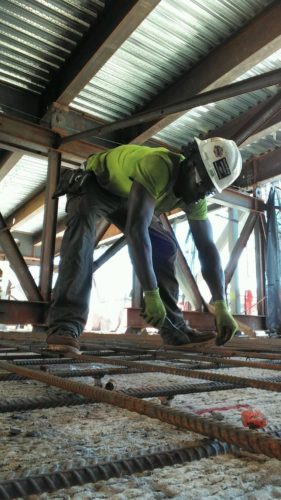When Superstorm Sandy struck New York City in 2012, the maelstrom blew open the urban landscape‚Äôs social¬Ýrifts. The devastation opportunely coincided with a surge¬Ýin Occupy Wall Street populist activism, which helped patch some of the immediate¬Ýwounds. But today, the political energy around ‚Äúsustainable‚Äù rebuilding has dissipated, though many impacted neighborhoods are still struggling. As the governments worldwide respond to climate crisis, the city‚Äîand the country‚Äîhas much to learn from Sandy‚Äôs aftermath.
As part of a long-term climate adaptation and mitigation effort, post-Sandy recovery has revealed many of the challenges that other cities will face as global warming escalates in the coming years: To safeguard cities from future disasters, cities need to improve¬Ýinfrastructural protection and promote ecologically conscious¬Ýurban planning. Locally this means creating resilient local food, transit and energy systems that are responsive to global environmental pressures and accountable to local communities. And all this needs to be done by putting communities to work with stable, living-wage jobs that improve the environmental and labor conditions of local workers.
And as cities prepare for the Trump administration, both activists and policymakers face new risks, and opportunities, in a renewed role for urban communities in building environmentally conscious local democracy.
AFTER SANDY
In some ways, New York City environmental-justice groups managed to avoid some of the mistakes seen in the wake of Hurricane Katrina on the Gulf Coast.¬ÝNew Orleans¬Ýrepresents the nightmare scenario of a city that has struggled to implement economic- and environmental-justice measures¬Ýafter environmental disaster left poor communities of color displaced, exposed to economic exploitation, and politically marginalized in the rebuilding efforts.
After Sandy devastated New York‚Äôs poor coastline neighborhoods, the community-labor coalition ALIGN seized on the recovery effort to develop a model for¬Ýrebuilding fairly in the most vulnerable communities.
The city‚Äôs official rebuilding program, Build it Back (BIB),¬Ýhas been criticized for bureaucratic snares, frustrating financial shortfalls, and project delays.
BIB’s workforce program aimed to avoid the exploitation witnessed after Hurricane Katrina on the Gulf Coast, where recovery resources were squandered through undemocratic, exploitative “development” policies and rampant corruption. Similar injustices surfaced in the early days of post-Sandy recovery. Over half of the city’s Sandy victims were low-income renters. More than 620,000 impacted residents, mostly from communities of color, lived within half a mile of key shoreline industrial areas, leaving them doubly vulnerable to future disaster.
The migrant day-labor force that drove the initial reconstruction efforts also suffered widespread labor abuses due to their systematic exclusion from both labor protections and basic emergency relief.
Amidst this bureaucratic bungling, grassroots environmental-justice groups have been working quietly and steadily to forge equitable climate protection for all.
 One example: ALIGN collaborated with the citywide Alliance for a Just Rebuilding to spearhead a post-Sandy jobs program based on a locally focused project labor agreement, which has yielded nearly 1,000 jobs, and guarantees prevailing wages standards and labor protections. A union-linked apprenticeship initiative aided employment for women and veterans, while a 20-percent local hiring goal gave residents a stake in rebuilding their neighborhoods.
One example: ALIGN collaborated with the citywide Alliance for a Just Rebuilding to spearhead a post-Sandy jobs program based on a locally focused project labor agreement, which has yielded nearly 1,000 jobs, and guarantees prevailing wages standards and labor protections. A union-linked apprenticeship initiative aided employment for women and veterans, while a 20-percent local hiring goal gave residents a stake in rebuilding their neighborhoods.
This project labor agreement, according to ALIGN, provided avenues toward living-wage jobs while resisting the tendency for shady contractors to exploit informal workers; this proved “critical in restricting the ability of employers to engage in these unscrupulous practices.”
Still, post-Sandy recovery has proceeded unevenly. BIB’s construction pipeline currently contains some 5,565 projects, nearly half of them complete. But these are primarily single-family private homes; just a small fraction target multiple-family dwellings, like co-ops. This doesn’t necessarily mean relief has been unfairly denied to larger structures, as projects are based on complex property-needs assessments. Yet the city’s overall focus on restoring single-family residences, rather than multifamily housing, may overlook unmet needs in communities dominated by rental housing. Though renters received emergency housing subsidies through a separate program, the city faces acute needs for revamping public housing, where working-class families are clustered.
But labor equity is a key link to the recovery‚Äôs social aspect. ALIGN sees its workforce program as a ‚Äúnational model‚Äù for recovery that¬Ýprioritizes social inclusion¬Ýover speed and profit. To upscale¬Ýthis framework, ALIGN Executive Director Maritza Silva-Farrell says, vulnerable neighborhoods should be holistically ‚Äúrebuilt in a way that would have long-term protections.‚Äù According to Silva-Farrell, though integrative rebuilding efforts might cost a little more and may take more time, they ‚Äúactually will protect these neighborhoods in the long term, rather than just the moment-of,‚Äù in areas plagued by intensifying climate stress.
To read the full article, visit The Nation